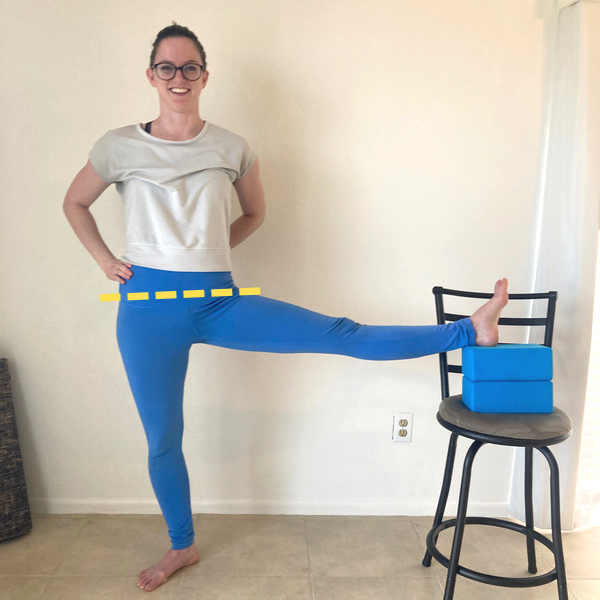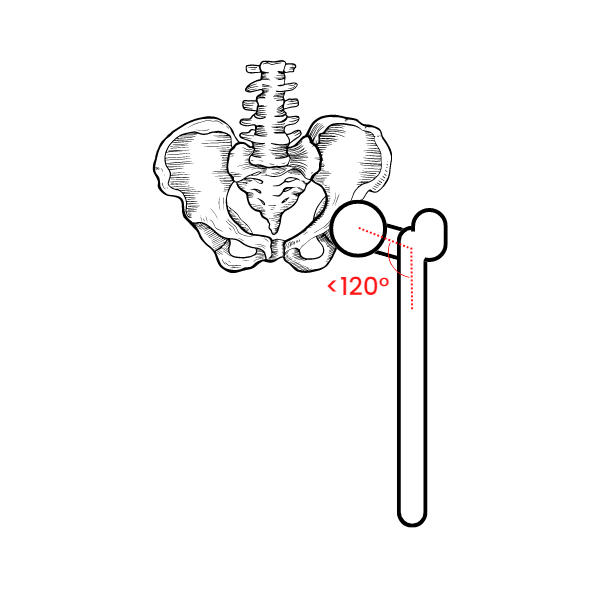Is It Anatomically Possible for Me to Do the Middle Splits?
Is It Anatomically Possible for Me to Do the Middle Splits?
How Hip Anatomy Impacts Middle Splits
Hip anatomy - which includes the bony structure of the femur (thigh bone), the bony structure of the pelvis (hip bones), and all the soft tissue (ligaments, muscles, etc) connecting the two - can vary pretty widely body to body. The differences in hip shape between a male and female pelvis alone are so drastic, we can use them to identify the sex of a skeleton just from looking at the hips!
You may have heard that some people have a hip anatomy/structure that makes it impossible for them to ever do flat middle splits. You may have even seen a common test (spoiler alert: this “test” is crap) to show whether or not you have a boney limitation that would make middle splits impossible for you:
So let’s take a deeper dive into variations in hip anatomy to understand how they impact the ability to do middle splits, and how likely it may be that you have one of these variations.
Thigh Bone Shape (Coxa-what?)
While there are several common ways folks’ hips can vary, one of the most often cited ones when it comes to middle splits is variation in the angle between the neck and the shaft of the femur (thigh bone), sometimes referred to as the NSA (neck-shaft angle):
“Normal” Femur (Thigh Bone)
Femur neck-shaft angle: 120°-135° (notice that’s actually quite a wide range that’s considered “normal”)
Prevalence*: the vast majority of the population has this type of femur, with some natural variation occurring.
Femur with Coxa Valga
Femur neck-shaft angle: >135° (increased angle, making middle splits a little easier)
Prevalence*: 16/1000 newborns (0.16%)
* I tried to find legitimate scientific research to site for the prevalence of these variations in the general population, but couldn’t find anything. These numbers are estimates from (non scientific) medical articles I found on Google.
Femur with Coxa Vara
Femur neck-shaft angle: <120° (deacreased angle, making middle splits more challenging)
Prevalence*: 1/13,000 to 1/25,000 newborns (<0.01%), more common in bodies with cerebral palsy. Often presents along with a leg length discrepancy and a limp.
This neck-shaft angle can have a very real impact on how wide we can open our legs in a straddle. If you take a closer look at the bony structure of our femur (thigh bone), you’ll notice there’s a big ginormous club-shaped part that sticks out of the top/side of the shaft of the femur - this is the greater trochanter. This is typically the part of our femur that eventually makes contact with our hip bone, causing a hard block, and preventing us from opening our legs any wider. This is why some people sometimes feel a “pinching” sensation in their outer hips, or like there’s a hard blockage, when trying to straddle or middle split.
Let’s take a look at a hip with a “typical” NSA angle in a middle split, vs a hip with coxa vara (which has a narrower NSA angle in the femur):
This is a pretty gross oversimplification, but you get the general idea: bodies with coxa vara (and a narrower neck-shaft angle in their thigh bone) will have a more limited range of motion when it comes to middle splits and straddles. For some bodies with coxa vara, it may be impossible to physically hit a 180 degree middle split.
The Problem with the Classic “Can You Kick Your Leg Out on a Table” Middle Split Ability Test
Here’s a common “test” I mentioned in the introduction you may have seen floating around the internet that supposedly helps test if you have the “proper” hip anatomy to do a full flat middle split (or straddle, remember they are essentially the same shape): Kick your leg out to the side (thigh and knee facing the ceiling) on a surface that’s at hip height. If you can comfortably do this without your hips tilting to the side, you can do a middle split! The problem is that “test” is totally inaccurate.
Here’s a look at my fiancé Nate and me doing this “test:”
As you can see, Nate’s got some tight hips, and he compensates by tilting them to the side when he lifts his leg. Does this mean he has coxa vara or some other bony obstruction preventing him from doing the middle splits? Not necessarily. In fact, Nate can actually get his hips hella wide in a frogger stretch, it’s just straight-legged open hip positions that are a challenge (which means it’s much more likely that a tight gracillis is what’s limiting his middle splits).
Now for me, I can already do middle splits, and even middle oversplits (on a good day). But the simple act of kicking my leg up and holding it here does feel like a stretch.
The moral of the story: this “test” is a better assessment for can you already do the middle splits.
Only a medical professional can officially diagnose coxa vara (often with a simple x-ray), not some random internet self-test.
The “Good” News: It’s Extremely Statistically Unlikely For You to Have Coxa Vara
But even if you do have coxa vara, depending on your hip anatomy, it may still be possible to do middle splits if you focus on using more hip external rotation when you open your legs, meaning either trying to rotate your thigh bones backwards in space, or tilt the top of your hips forwards towards the floor more, to give you more space in the hip joint to move. This is something a physical therapist can help evaluate and assess in your body.
The Other “Good” News: Hip Anatomy Variations Are Normal, and You Can Adjust Your Training Accordingly
There are loads of other hip/femur variations - from femoral anteversion or retroversion (a different variation in the angle between the neck and shaft of the femur), differences depth and shape of the acetabulum (hip socket), and large differences between male and female pelvises in general - that can impact how easy/challenging it may be for your body to achieve middle splits. Heck, you may have even noticed how wide of a “normal” variation there is in the neck-shaft angle there can be in the discussion above. Everybody’s body is different! Heck, I’ve even worked with students who have a hip anatomy that makes middle split training feel even easier than front split training (which is very much not my hip anatomy, so it always blows my mind to work with people like this!).
That means the vast majority of people can work towards a version of a flat middle split, but your versions of the stretch may look slightly different from another person’s since you have Special Unique Snowflake Hips. This is especially true when it comes to pelvic tilt, which is one of the easier ways for us to adjust and moderate stretches to ensure they are feeling like productive muscle stretches, and not unproductive bone crunching activities. Here’s a whole blog post on how to adjust your middle splits to better fit your unique hip anatomy.









